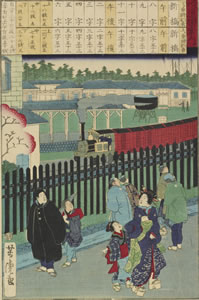Art lovers will be able to enjoy previously unseen works of art thanks to an exciting new gallery opening at the National Railway Museum in York this summer. The brand new purpose-built exhibition space will officially open on 18 July and is funded by The Foundation for Sport and the Arts. The first headline exhibition in the gallery will be 'Japan's First Railway: colour woodblock prints from the 1870s'.
To mark the 10th anniversary of the arrival of the shinkansen (bullet train), which is still the only shinkansen on display outside Japan, the exhibition will showcase Japanese Meiji era woodblock prints. Loaned from The Modern Transportation Museum in Osaka, these stunning prints reflect the period of 'railway mania' which surrounded the opening of the first Japanese railway line between Tokyo and the port of Yokohama in 1872.
In the 19th century the woodblock print industry was a way of producing inexpensive, multi-colour prints for a mass audience. In the 1870s the Japanese public were swept away by the glamour of the railway, with thousands viewing the inaugural ceremonies during which the young Emperor himself rode on the train. It was a symbol of a bold new era for Japan, as previously the Emperor had lived a closeted life hidden away in Kyoto. Now the 15-year-old who came to the throne in 1868 was a figurehead for a modern state based in the new capital of Tokyo. |

Image: Modern Transport Museum, Osaka |


